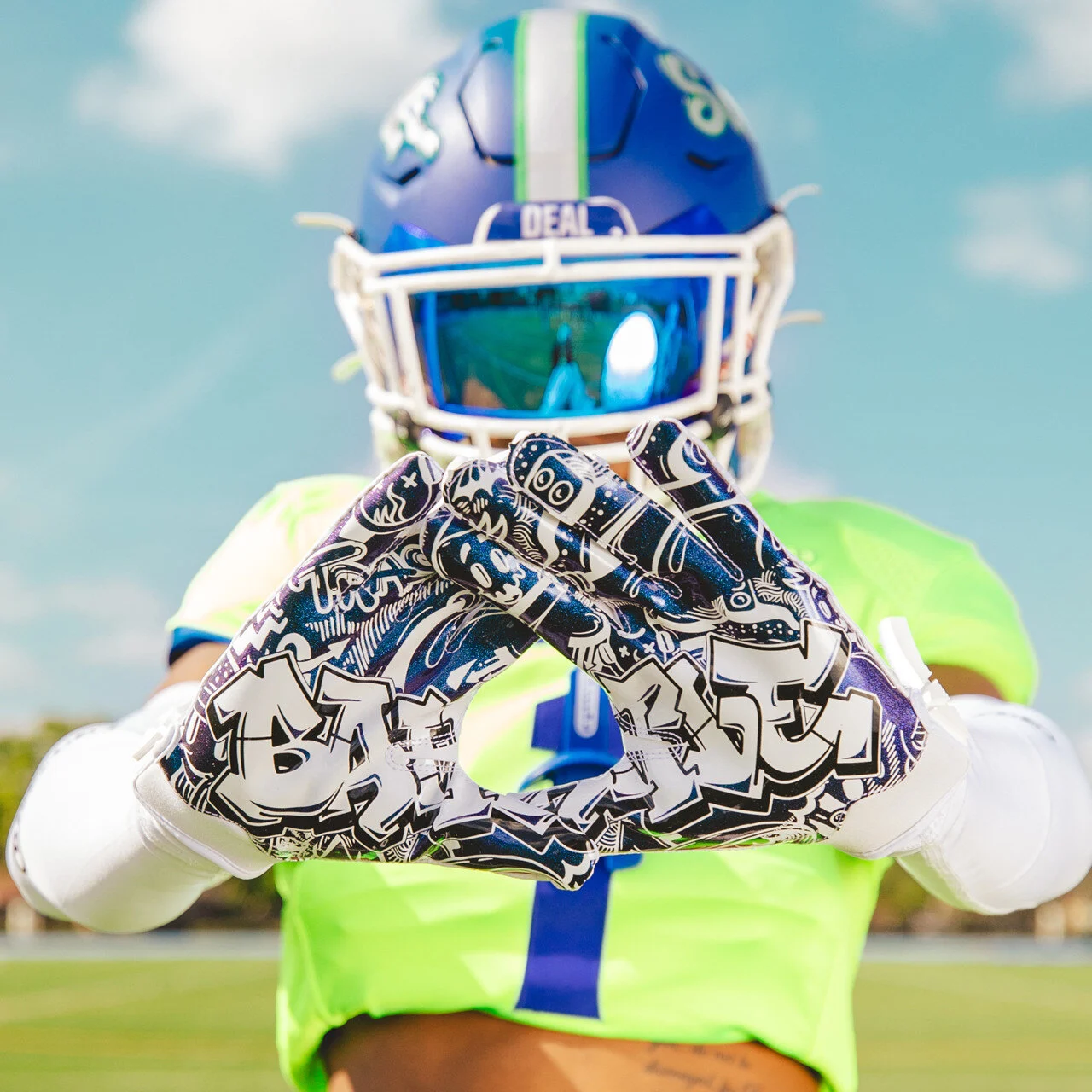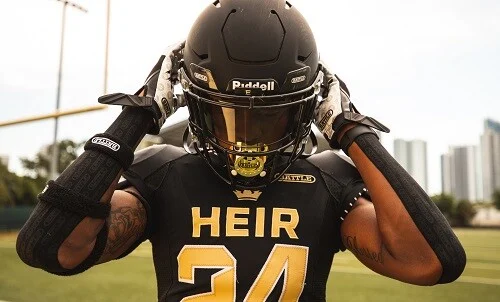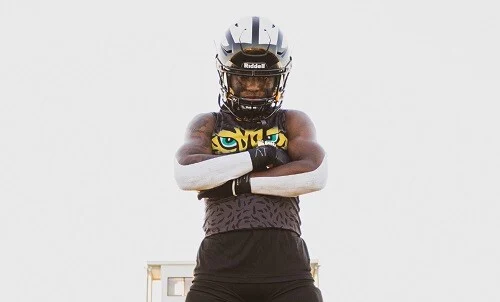
Football is the ultimate team sport. When you and your crew hit the gridiron, each one of you plays an important role in leading your team to victory.Â
This might have you wondering, “What football position should I play?â€
Identifying your ideal position on the team can be a game-changer—literally. That’s why we’re reviewing the skills and strengths required for each role. Remember, no matter which position you choose, having the right football gear is essential for both performance and safety, and that’s where we at Battle Sports come into play.Â
Discover your ideal position below so that you can hit the field with confidence.Â
The Importance of Position Fit in Football
Understanding the football position you were made for is key to unlocking your full potential as a player and contributing to your team’s success. Why?Â
Think about it like this: When you’re playing a position that aligns with your skills and strengths, you can focus more of your energy on collaborating with your teammates and executing a flawless game plan. For instance, if you have strong leadership and decision-making skills, you can take on the role of quarterback and effectively coordinate with receivers, the offensive line, and running backs.
Put simply, when you can crush it in your position, your team can operate like a well-oiled machine.
Overview of Offensive, Defensive, and Special Teams Positions
An NFL football roster has 53 players, split into three main categories: offensive, defensive, and special teams. Each group also has varied specialist positions for different roles.Â
Here’s what you need to know about the groups:
- Offensive – The role of the offensive players is to score points for the team by advancing the ball to the opponent’s end zone. Positions in this group include quarterbacks, receivers, backs, and linemen.
- Defensive – This group’s main role is to prevent the opposing team from advancing toward their end zone to score points. Positions include linemen, backs, linebackers, and safeties.
- Special Teams – These are players called onto the field during special kicking plays like kickoffs, field goals, extra point entries, and punts. Positions include kicker, punter, kick returner, punt returner, and long snapper.
Depending on your skills and strengths, you can fall into any of these groups. It’s also possible to be in all three groups—but you’ll need specialized skills to be called for specific plays like field goals and kickoffs.

Factors to Consider When Choosing a Football Position
“What football position should I play?†To answer this question, you have to understand the key factors coaches and scouts consider when identifying players for football positions.
Physical Attributes and Body Type
Your height, weight, and build can all influence which positions are a natural fit. For example, linemen tend to carry a few extra pounds on the field as they need brute strength to go against other players. Meanwhile, quarterbacks typically have a tall stature for better vision, plus strong arms for powerful and accurate throws.
Speed, Agility, and Endurance
Speed and agility are essential for positions like wide receiver and cornerback. Think about it like this: A linebacker needs to run fast to hunt down ball carriers and take them out, and a wide receiver must be swift to catch forward passes from QBs.
These skills are also essential for players who often change direction or move around the field a lot, like a slot receiver, tight end, defensive back, and kick returner.
Strength and Physicality
Linebackers, offensive linemen, defensive linemen, and fullbacks need serious strength to take down running backs, disrupt plays, and break through defenses.
For instance, offensive linemen are tasked with blocking defensive players, protecting the quarterback, and holding the line of scrimmage. On the other hand, linebackers must have the physical power to shed blocks and blitz the quarterback.
Mental Toughness and Leadership
Physical skills are an obvious must-have when it comes to any sport. But what about mental toughness and leadership skills?Â
These attributes can seriously come in handy for positions like quarterback, middle linebacker, safety, and center. All of these roles require quick decision-making while under pressure.Â
The quarterback’s leadership on the field is also essential to maintaining team focus and morale.
Offensive Positions and Which One Might Be Right for You
Let’s dive a bit deeper into the different offensive positions to help you determine the right fit.
Quarterback (QB)
The quarterback is the key decision-maker, responsible for managing the game and keeping team morale high.1 This position is ideal for players with a high-game IQ, laser-sharp accuracy, and the ability to move around the pocket. QBs tend to be tall with good vision and strong arms.
Tom Brady, Aaron Rodgers, Patrick Mahomes, and Peyton Manning are some of the most popular QBs.
Running Back (RB)
A running back is responsible for carrying the ball after receiving a pass from a QB. They also attempt to break defenses and tackles to give the team an upper hand in plays.
RBs can be fullbacks or halfbacks, but both need speed, strength, and agility to avoid tackles and break through defenders. They tend to be shorter, compact, and masculine. Christian McCaffrey, Barry Sanders, and LaDainian Tomlinson have excelled in this position.
Wide Receiver (WR)
Also referred to as a wideout, a wide receiver is responsible for catching the ball thrown by a QB. They line up at or near the line of scrimmage and are usually the fastest offensive players.
WRs are typically tall, lean, and fast, enabling them to outrun or out-jump defenders. They also need strength, great hands, and remarkable athleticism. Some popular WRs include Marvin Harrison, Jerry Rice, Randy Moss, Larry Fitzgerald, and Terrell Owens.
If being a receiver sounds like a good fit for you, check out our blog to learn how to choose football gloves that are best for this position.
Offensive Linemen (OL)
Offensive linemen defend the quarterback and running backs by blocking defensive players. They tend to be the largest players on the team—that’s because they need strength, bulk, and power to win the battle at the line of scrimmage.
The offensive line usually has five players: one center, two guards, and two offensive tackles. Some top OLs include Penei Sewell, Bernhard Raimann, Taylor Decker, and Trent Williams.
Defensive Positions and Which One Might Be Right for You
If you want to stop the opponent’s offense from scoring or moving the ball, here are the positions you need to know2:
Linebacker (LB)
Linebackers play behind the defensive line. There are usually three or four on the field depending on the number of defensive linemen. They captain the defense, stop runs, and defend passes.
LBs are smaller and faster, requiring a balance of size and speed to tackle effectively and cover ground quickly. Examples of top LBs include Fred Warner, Demario Davis, and Roquan Smith.
Defensive Linemen (DL)
Defensive linemen’s role is to overpower offensive players to disrupt plays, stop the run, and tackle the quarterback. Like offensive linemen, DLs are bigger players and require brute strength to shred blockers.
There are normally three or four DLs on a team. Some notable DLs include Jeffer Simmons, Chris Jones, and DeForest Buckner.
Cornerback (CB) and Safety (S)
Also known as defensive backfield or defensive backs, cornerbacks and safeties play at the back of the defense to cover the offense’s best receivers, keeping them from catching the ball by getting in their way or tackling them.
Note that CBs are faster than safeties, making them better at covering the offensive receivers. On the other hand, safeties help keep the defense aligned, so leadership is essential for this position.
Special Teams: A Unique Path to the Field
You can also earn a spot in the safety team if you can handle punts, kickoffs, extra point tries (PATs), and field goals.
Kicker and Punter
As the name suggests, the kicker kicks the ball off the ground on a field goal, point after touchdown (PAT), and kickoff. The punter receives the ball from the line of scrimmage and punts it to the opponents to keep them away from the end zone.Â
Long Snapper
Also referred to as a deep snapper, a long snapper is a special center that snaps the ball to a punter or holder. They’re also responsible for punt coverage and blocking after a snap.

How to Test Out Different Football Positions
Testing different positions can help you determine the role that best suits your strengths, skills, and physical attributes. During pickup games or team practices, request to try positions like running back, wide receiver, linebacker, and others.
Most importantly, work with your mentors and coaches to get insights into your performance. Based on their observations, they can recommend the positions that work well with your unique traits.
Gear Up for Your Position with Battle Sports
Discovering the football position that matches your natural talents and attributes is key to maximizing your performance on the field. For most new players, this isn’t a solo task—your coach can provide invaluable insights to help you figure out the position that’s right for you.
You can also work toward your desired position by assessing your strengths, skills, and personal style, and improving these attributes over time through targeted training and feedback.
As you embark on the journey of discovering your ideal position, make sure to equip yourself with the right football gear. This will not only keep you safe, but also enhance your performance and boost your confidence on the field.
At Battle Sports, we offer high-quality gear designed for durability, comfort, safety, and style. Whether you're a receiver looking for grip-enhancing football gloves or a lineman seeking a sturdy binky mouthguard, Battle Sports is your one-stop shop for football essentials and accessories.
Â
Sources:
- Stack. Football Positions: Explained. www.stack.com/a/football-positions/
- Dummies. Football For Dummies (USA Edition) Cheat Sheet. www.dummies.com/article/home-auto-hobbies/sports-recreation/football/football-for-dummies-usa-edition-cheat-sheet-208626/
- Southern Living. 50 Football Quotes For Game Day Inspiration. www.southernliving.com/culture/football-quotes
- AZBig Media. The different American football positions explained. azbigmedia.com/lifestyle/the-different-american-football-positions-explained/
- StudyFinds. Most Important Football Positions: Top 5 Essential Players, According To Experts. studyfinds.org/most-important-football-positions/
Non Stick Chip Baskets/Non Stick Oven Basket/Crisp Chips Basket is special for making chips,and
our patent of sealing ways, make no drops at all. Easier to take it off
from oven or microwave, it's also valid for many other foods.
The Non-stick chips basket allows perfect heat
circulation around chips, compared with traditional way, you don't need
to fry it in oil, it's clean and healthy cooking! There's a side
reinforcement sealing type, it's more easy to take it by hand, and
protect the food from any mesh drops.
The General Characteristics is:
- 100% non-stick
- Re-usable
- Open mesh allows heat recirculation around food, perfect cooking!
- Special for chips, no need to wrong about the drops
- Microwave and oven are safe up to 260°C
- Easy to clean, simply wash and dry between uses
- Complies with food regulations, was approved by FDA, LFGB etc.
Chip Baskets,Non Stick Chip Baskets,PTFE Chip Baskets,Non Stick Oven Basket,Crisp Chips Basket
NINGBO TIANSHUO (SUPERBRIGHT) TECHNOLOGY CO. LTD. , https://www.ptfe-supplier.com